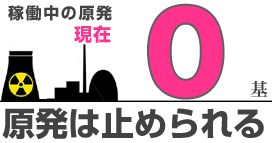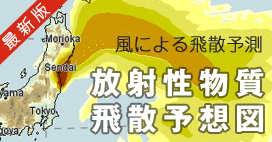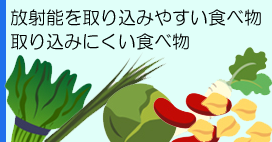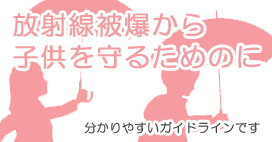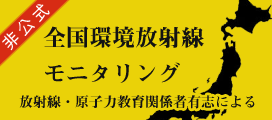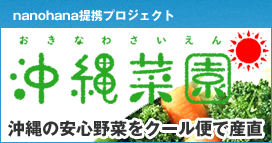福島原発事故による死者は、今後100万人以上と英紙が報道
9月 2nd, 2011 | Posted by in 1 体への影響と防御 | 1 広島・長崎・チェルノブイリ 他 | 1 放射能汚染 | 7 海外英紙インディペンデント電子版 8月29日 SearchChinaによる報道
3月に発生した東北大震災時に起こった福島原子力発電所の爆発事故による死亡者数が、今後100万人に達すると英紙インディペンデント電子版が29日(現地時間)、報道した。複数の韓国メディアがこの報道に注目し、詳細を伝えている。
韓国メディアは、今後、福島原発事故による死亡者が100万人に達すると英国のメディアが衝撃的な分析を行ったと報じた。
英インディペンデント紙は「なぜ福島災害はチェルノブイリよりも深刻なのか」と題し、複数の専門家の意見を紹介。オーストラリアの内科医で、反 核運動家のヘレン・カルディコット博士は、「福島に災いが近づいている」と警告。チェルノブイリ事故による死者は25年間で20万人に達したが、福島の事 故は、これより深刻だと指摘した。
また、英アルスター大学のクリストファー・バズビー教授は、「チェルノブイリ原子力発電所は、一度に爆発したが、福島原発では現在も放射性物質が出ており、チェルノブイリよりも状況が良くない。これから100万人以上が亡くなるだろう」と予想した。
金銭的被害も福島原発事故は、はるかに多く、チェルノブイリ事故は、1440億ポンド(約17.9兆円)と推算されるのに対し、日本は再建費用として1880億ポンド(約23.3兆円)を予想している。
一方、日本政府は、福島原発での漏えい放射性物質の量が1945年に広島に投下された原子爆弾の168倍に達したと明らかにした。専門家たちは、福島原発事故の被害は、まだ始まったばかりだと口をそろえているとして、事態の深刻さに言及した。
チェルノブイリ周辺で放射能が及ぼす遺伝的影響を研究してきた生物学者ティム・ムソー教授は、放射線被ばくが持続されると、健康に深刻な問題が 発生すると述べている。実際にチェルノブイリの近くでは、昆虫やクモの個体数が減り、鳥の脳の大きさが小さくなったことが明らかとなっていると語った。 (編集担当:李信恵・山口幸治)
SearchChinaによる報道
以下、インターネット上にあった、全文の翻訳 sorakumaより
8/29付でイギリスのインディペンデント紙に掲載されていたニュースを訳してみました。
訳にあまり自信がないので、元の英文も併記しています。
* * * *
Why the Fukushima disaster is worse than Chernobyl
福島原発事故がチェルノブイリを超える惨事となった理由について
Yoshio Ichida is recalling the worst day of his 53 years: 11 March, when the sea swallowed up his home and killed his friends. The Fukushima fisherman was in the bath when the huge quake hit and barely made it to the open sea in his boat in the 40 minutes before the 15-metre tsunami that followed. When he got back to port, his neighbourhood and nearly everything else was gone. “Nobody can remember anything like this,” he says.
イチダヨシオ氏は、53年の生涯で最悪となった日を思い起こしました。3月11日、それは津波が彼の家を、友人を飲み込んだ日のことです。
震災が発生した時、彼は入浴中でした。15メートルもの津波が押し寄せる40分ほど前に、なんとか船を沖に出すことができました。港に戻った時には、あらゆるものが失われてしまっていました。
『面影なんて、もう何も残っちゃいない』
Now living in a refugee centre in the ruined coastal city of Soma, Mr Ichida has mourned the 100 local fishermen killed in the disaster and is trying to rebuild his life with his colleagues. Every morning, they arrive at the ruined fisheries co-operative building in Soma port and prepare for work. Then they stare out at the irradiated sea, and wait. “Some day we know we’ll be allowed to fish again. We all want to believe that.”
イチダさんは今は、相馬市湾岸の避難施設で暮らしています。被災して亡くなってしまった土地の漁師たちを弔いつつ、復興のために心血を注いでいます。毎朝、漁師たちは相馬港の、共同漁業施設の跡地に向かい、復旧活動を続けています。イチダさんたち漁師は、放射能で汚染されたしまった海を見つめては待っているのです。
『いつの日か、また漁ができる日が来る』と。
This nation has recovered from worse natural – and manmade – catastrophes. But it is the triple meltdown and its aftermath at the Fukushima nuclear power plant 40km down the coast from Soma that has elevated Japan into unknown, and unknowable, terrain. Across the northeast, millions of people are living with its consequences and searching for a consensus on a safe radiation level that does not exist. Experts give bewilderingly different assessments of its dangers.
この地の人々は、幾度もの天災、あるいは人災からの復興を遂げてきました。しかし、相馬市から40キロ離れた福島原発で発生した3回のメルトダウンと、その影響により、日本は未知の領域に突入しつつあります。そんな中、東北地方では、数百万の人々が様々な事情から生活を続け、コンセンサスのとれた、安全な放射線レベルを求めています。そんなものは存在しないのにも関わらず、です。専門家たちは、放射能の危険性について一貫した回答を出すことが出来ず、様々な評価を下しています。
Some scientists say Fukushima is worse than the 1986 Chernobyl accident, with which it shares a maximum level-7 rating on the sliding scale of nuclear disasters. One of the most prominent of them is Dr Helen Caldicott, an Australian physician and long time anti-nuclear activist who warns of “horrors to come” in Fukushima.
科学者の中には福島は1986年のチェルノブイリ事故を遥かに超えているという者もいます。福島もチェルノブイリも、原発事故の国際評価基準における最大のレベル7にあたります。
その急先鋒がオーストラリアの物理学者で、長年にわたり反原発活動を続けているヘレン・カルディコット博士です。博士は、福島に災厄が訪れるだろう、と警鐘を発しています。
Chris Busby, a professor at the University of Ulster known for his alarmist views, generated controversy during a Japan visit last month when he said the disaster would result in more than 1 million deaths. “Fukushima is still boiling its radionuclides all over Japan,” he said. “Chernobyl went up in one go. So Fukushima is worse.”
お騒がせで有名な 英アルスター大学のクリス・バズビー教授は、先月日本を訪れていた折、この災害により、100万人以上もの人々が死ぬことになると発言して物議を醸しています。
『福島は未だに日本全体に放射能をまき散らしています』
『チェルノブイリはただ一つ原子炉の事故でした。それゆえに、福島は一層深刻です』
On the other side of the nuclear fence are the industry friendly scientists who insist that the crisis is under control and radiation levels are mostly safe. “I believe the government and Tokyo Electric Power [Tepco, the plant's operator] are doing their best,” said Naoto Sekimura, vice-dean of the Graduate School of Engineering at the University of Tokyo. Mr Sekimura initially advised residents near the plant that a radioactive disaster was “unlikely” and that they should stay “calm”, an assessment he has since had to reverse.
一方、日本の所謂 御用学者たちは、危機は既に収束し、放射能レベルはおおむね安全であると主張しています。
東京大学のセキムラナオト教授は、『政府と東京電力は、最善を尽くしていると信じています』と述べています。
セキムラ氏は当初、原発近隣の住民に対し、原発近隣の住民に対し、放射性災害は現実的ではない、とし『冷静に行動して欲しい』とアドバイスしていましたが、実態を知って、意見を翻さざるを得なくなりました。
Slowly, steadily, and often well behind the curve, the government has worsened its prognosis of the disaster. Last Friday, scientists affiliated with the Nuclear and Industrial Safety Agency said the plant had released 15,000 terabecquerels of cancer-causing Cesium, equivalent to about 168 times the 1945 atomic bombing of Hiroshima, the event that ushered in the nuclear age. (Professor Busby says the release is at least 72,000 times worse than Hiroshima).
ゆっくりと、しかし着実に、政府は原発災害の予測を下方修正していきました。
8月26日、原子力安全・保安院の科学者は、原発から15000テラベクレルもの放射性セシウムが放出されていることを公表しました。
その規模は1945年の広島原爆に換算するとおよそ168発分に相当します。(バズビー教授は、少なくとも72000発以上である、としています)
Caught in a blizzard of often conflicting information, many Japanese instinctively grope for the beacons they know. Mr Ichida and his colleagues say they no longer trust the nuclear industry or the officials who assured them the Fukushima plant was safe. But they have faith in government radiation testing and believe they will soon be allowed back to sea.
情報の錯綜する中、多くの日本人が独自に調査を開始しました。イチダ氏たちも、もう原発産業も御用学者たちも信じられない、と言います。それでも、政府の放射線調査を信じ、すぐに海に戻る許可が降りると信じているのです。
That’s a mistake, say sceptics, who note a consistent pattern of official lying, foot-dragging and concealment. Last week, officials finally admitted something long argued by its critics: that thousands of people with homes near the crippled nuclear plant may not be able to return for a generation or more. “We can’t rule out the possibility that there will be some areas where it will be hard for residents to return to their homes for a long time,” said Yukio Edano, the government’s top government spokesman. “We are very sorry.”
政府の嘘や偽装、隠蔽を指摘してきた懐疑論者に言わせれば、それは間違いだと言います。
先週、政府はついに、批評家たちが長い間論じてきたある事を認めました。原発近隣の、何千人もの人々は、1世代、あるいはそれ以上長い間、戻ることはできない、と。
政府の長官であり、スポークスマンである枝野氏は次のように語りました。
『一部地域の住民は、長期間にわたって帰宅できない可能性があります』
『本当に、申し訳ありません』
Last Friday, hundreds of former residents from Futaba and Okuma, the towns nearest the plant, were allowed to visit their homes – perhaps for the last time – to pick up belongings. Wearing masks and radiation suits, they drove through the 20km contaminated zone around the plant, where hundreds of animals have died and rotted in the sun, to find kitchens and living rooms partly reclaimed by nature. “It’s hard to believe we ever lived here,” one former resident told NHK.
先週金曜日、原発に最も近い双葉町と大熊町の数百人の住民が、所有物を持ち出すため、あるいは最後となるかもしれない一時帰宅を認められました。マスクや対放射性装備に身を包み、原発周辺の20km圏内を通過すると、そこでは、何百匹もの動物が死に、野ざらしとなり、キッチンやリビングが野に飲まれつつありました。
『ここに住んでいたことが、信じられません』
ある農民がNHKにコメントしています。
Several other areas northwest of the plant have become atomic ghost towns after being ordered to evacuate – too late, say many residents, who believe they absorbed dangerous quantities of radiation in the weeks after the accident. “We’ve no idea when we can come back,” says Katsuzo Shoji, who farmed rice and cabbages and kept a small herd of cattle near Iitate, a picturesque village about 40km from the plant.
原発の北西に位置する、いくつかの地域では避難命令の後、ゴーストタウンと化しました。
事故から数週間後、既に致命的な被曝をしたと思われる多くの人々は、あまりにも遅すぎたのだ、と言います。
原発からおよそ40kmほどの離れた美しい村、飯舘村で米やキャベツを栽培し、酪農をしていたショウジ氏は『帰ってこれるかどうか、わからない』と言っています。
You can follow any responses to this entry through the You can leave a response, or trackback.


